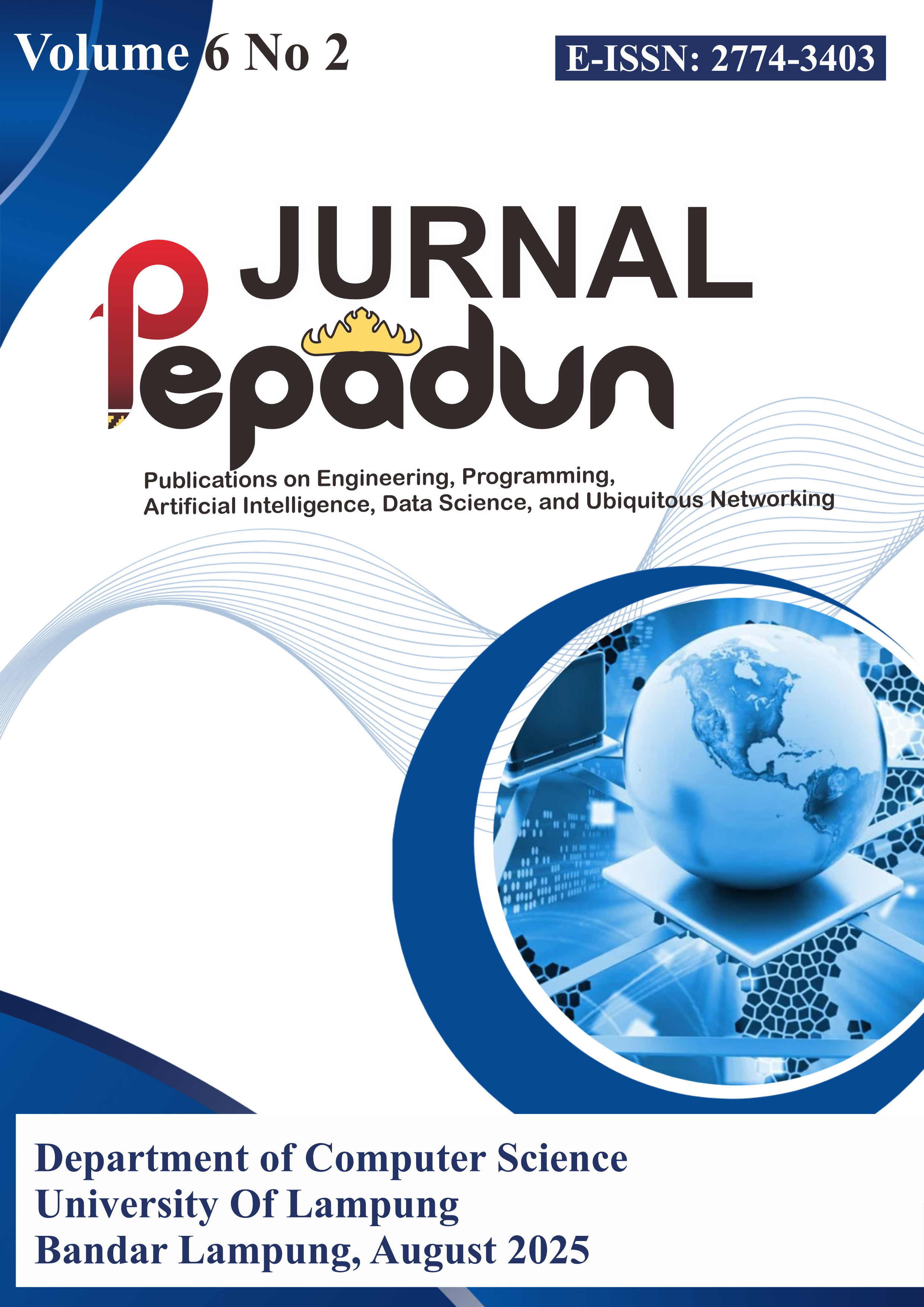Geographic Information System for Mapping the Distribution of Lampung Medicinal Plants
Main Article Content
Abstract
Medicinal plants are one of the potential natural resources that grow in Indonesia. Data on the location of medicinal plants is currently still scattered in several places. This research goals to develop and apply Geographic Information Systems (GIS) as an innovative tool in the conservation and utilization of medicinal plants. By combining Geographic Information System technology and empirical data on the location of medicinal plants, this research presents a platform that allows researchers, health practitioners, and the general public to access information related to the geographic distribution and properties of medicinal plants. This research utilizes the Codeigniter framework as the basis for system development and is assisted by several libraries, such as GeoJSON and LeafletJS, for several parts of the system. The result of this research is a basic web-based system about medicinal plant mapping that can be further developed into further research. The research has successfully produced a system that can display the mapping of medicinal plants in several regions in Lampung province. The main difficulty experienced is the precision of the location of medicinal plants. The weakness of the system is that the markers look like they merge when seen from a specific altitude. Future research will develop a search engine for medicinal plant information that is integrated with the location mapping that has been produced from this research. So when people want to search for a medicinal plant, they will get the information easily
Article Details

This work is licensed under a Creative Commons Attribution-NonCommercial-ShareAlike 4.0 International License.
References
A. Bauskar, S. Soni, S. Mahadik, and M. Pawar, “Gis Based Inventory of Sports Infrastructure,” Int. Res. J. Mod. Eng. Technol. Sci., vol. 05, no. 03, pp. 1611–1613, 2023, doi: 10.56726/irjmets34485.
Z. Li and H. Ning, “Autonomous GIS: the next-generation AI-powered GIS,” Int. J. Digit. Earth, vol. 16, no. 2, pp. 4668–4686, 2023, doi: 10.1080/17538947.2023.2278895.
A. M. Carballada and J. B. Barreiro, “Geospatial analysis and mapping strategies for fine-grained and detailed covid-19 data with gis,” ISPRS Int. J. Geo-Information, vol. 10, no. 9, 2021, doi: 10.3390/ijgi10090602.
J. Vinueza-Martinez, M. Correa-Peralta, R. Ramirez-Anormaliza, O. Franco Arias, and D. Vera Paredes, “Geographic Information Systems (GISs) Based on WebGIS Architecture: Bibliometric Analysis of the Current Status and Research Trends,” Sustain., vol. 16, no. 15, 2024, doi: 10.3390/su16156439.
F. Jamshidi-Kia, Z. Lorigooini, and H. Amini-Khoei, “Medicinal plants: Past history and future perspective,” J. HerbMed Pharmacol., vol. 7, no. 1, pp. 1–7, 2018, doi: 10.15171/jhp.2018.01.
O. Oyebode, N. B. Kandala, P. J. Chilton, and R. J. Lilford, “Use of traditional medicine in middle-income countries: A WHO-SAGE study,” Health Policy Plan., vol. 31, no. 8, pp. 984–991, 2016, doi: 10.1093/heapol/czw022.
S. Liu, B. Zhang, Q. Lei, J. Zhou, M. Ali, and C. Long, “Diversity and traditional knowledge of medicinal plants used by Shui people in Southwest China,” J. Ethnobiol. Ethnomed., vol. 19, no. 1, 2023, doi: 10.1186/s13002-023-00594-4.
C. C. Davis and P. Choisy, “Medicinal plants meet modern biodiversity science,” Curr. Biol., vol. 34, no. 4, pp. R158–R173, 2024, doi: 10.1016/j.cub.2023.12.038.
S. Mutola, N. V. Pemunta, and N. V. Ngo, “Utilization of traditional medicine and its integration into the healthcare system in Qokolweni, South Africa; prospects for enhanced universal health coverage,” Complement. Ther. Clin. Pract., vol. 43, no. April 2021, p. 101386, 2021, doi: 10.1016/j.ctcp.2021.101386.
A. G. Atanasov, S. B. Zotchev, V. M. Dirsch, and C. T. Supuran, “Natural products in drug discovery: advances and opportunities,” Nat. Rev. Drug Discov., vol. 20, no. 3, pp. 200–216, 2021, doi: 10.1038/s41573-020-00114-z.
A. Jamal, “Embracing Nature’s Therapeutic Potential: Herbal Medicine,” Int. J. Multidiscip. Sci. Arts, vol. 2, no. 1, pp. 2962–1658, 2023, [Online]. Available: https://doi.org/10.47709/ijmdsa.vxix.xxxx
N. A. Chugh, S. Bali, and A. Koul, “Integration of botanicals in contemporary medicine: road blocks, checkpoints and go-ahead signals,” Integr. Med. Res., vol. 7, no. 2, pp. 109–125, 2018, doi: 10.1016/j.imr.2018.03.005.
J. R. Tibenderana, M. M. Ndalla, and S. A. Kessy, “Spatial insights unleashed: unlocking the potential of geospatial data,” Int. J. Surg. Glob. Heal., vol. 6, 2023, doi: 10.1097/gh9.0000000000000354.
J. Yang, F. Wu, E. Lai, M. Liu, B. Liu, and Y. Zhao, “Analysis of Visualization Technology of 3D Spatial Geographic Information System,” Mob. Inf. Syst., vol. 2021, pp. 1–9, 2021, doi: 10.1155/2021/9173281.
A. Sah, S. D. Prakoso, and M. Tonggiroh, “Geographic Information Systems of Small Industry Development During Pandemic,” J. Teknol. Dan Open Source, vol. 4, no. 2, pp. 141–148, 2021, doi: 10.36378/jtos.v4i2.1411.
M. D. Chaniago and H. M. Taki, “Geographic Information System (GIS) as an Information Media in the Field of Environmental Health: Literature Review,” J. Appl. Geospatial Inf., vol. 6, no. 2, pp. 641–646, 2022, doi: 10.30871/jagi.v6i2.4319.
N. A. Alzahrani, S. N. H. Sheikh Abdullah, I. Mohamed, and M. Mukred, “The Adoption of Geographic Information Systems in the Public Sector of Saudi Arabia: A Conceptual Model,” Math. Probl. Eng., vol. 2021, 2021, doi: 10.1155/2021/1099256.
E. S.- Manzano, J. A. G.- Cardenas, and F. M.- Agugliaro, “Worldwide research trends on medicinal plants,” Int. J. Environ. Res. Public Health, vol. 17, no. 10, 2020, doi: 10.3390/ijerph17103376.
Y. Nugroho, M. A. Soendjoto, Suyanto, J. Matatula, S. Alam, and P. Y. A. P. Wirabuana, “Traditional medicinal plants and their utilization by local communities around Lambung Mangkurat Education Forests, South Kalimantan, Indonesia,” Biodiversitas, vol. 23, no. 1, pp. 306–314, 2022, doi: 10.13057/biodiv/d230137.
W. M. Kansha, Saherih, and Muchlis, “Analisis Perbandingan Struktur dan Performa Framework Codeigniter dan Laravel dalam Pengembangan Web Application,” J. Tek. Inform. STMIK Antar Bangsa, vol. 9, no. 1, pp. 25–31, 2023.
